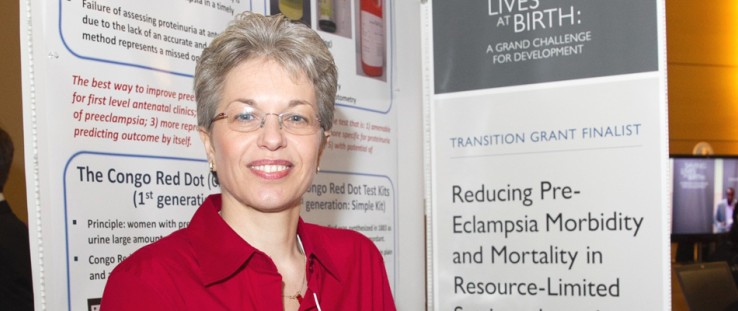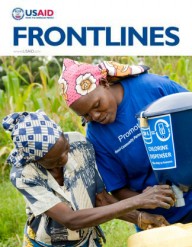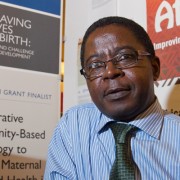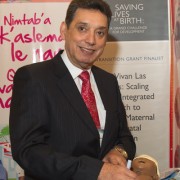 A team led by Dr. Irina Buhimschi, director of the Center for Perinatal Research at Nationwide Children’s Hospital in Ohio, went through more than 400 different types of paper before they found the ideal selection that shows accurate results.
USAID
A team led by Dr. Irina Buhimschi, director of the Center for Perinatal Research at Nationwide Children’s Hospital in Ohio, went through more than 400 different types of paper before they found the ideal selection that shows accurate results.
USAID
 A team led by Dr. Irina Buhimschi, director of the Center for Perinatal Research at Nationwide Children’s Hospital in Ohio, went through more than 400 different types of paper before they found the ideal selection that shows accurate results.
USAID
A team led by Dr. Irina Buhimschi, director of the Center for Perinatal Research at Nationwide Children’s Hospital in Ohio, went through more than 400 different types of paper before they found the ideal selection that shows accurate results.
USAID
“Sometimes it’s the simplest things,” says Dr. Irina Buhimschi, director of the Center for Perinatal Research at The Research Institute at Nationwide Children’s Hospital and a professor at Ohio State University.
In this case, the researcher is referring to the discovery that conducting a urine test for preeclampsia on plain paper bested the same test using a more sophisticated type of paper. But the wow moment celebrating simplicity came after much more arduous work to discover how a buildup of specific protein molecules in the body can predict the illness that is responsible for 40 percent of preterm births. The disease brings on extremely high blood pressure without notice in pregnant women, and requires immediate delivery.
“Preeclampsia is a disease of unknown cause and it has been puzzling researchers for hundreds of years,” Buhimschi explained. “A lot of obstetricians and a lot of maternal specialists are fascinated with this disease because it is so mysterious.”
Scientists know that proteins play a role, but the goal for Buhimschi and her team was to find a way to diagnose the illness earlier and more accurately. That way women can be referred to a higher level of care where the fetus can be monitored and other interventions can be tried to stabilize the pregnancy for as long as possible.
“Preeclampsia needs to be recognized, because the woman can … harbor this disease without a lot of symptoms,” she said.
Her research began about six years ago looking for and studying the particular signature, or fingerprint, of several proteins implicated in preeclampsia. Similar techniques are used in the study of Alzheimer’s disease. Once the fingerprint was identified that correctly predicted preeclampsia, the researchers set out to produce a test to measure it.
Buhimschi’s team developed the Congo Red Dot test, which mixes colored dye with a sample of a pregnant woman’s urine. The reaction on the paper reveals whether or not the woman’s proteins have the telltale signs of preeclampsia.
The team tried more than 400 kinds of paper to find the one that produced the best result—which turned out to be the same type of paper used to make mailing labels.
Trials in South Africa helped prove the point: “Plain paper rather than a more sophisticated paper enabled a test that had the results in a few minutes,” said Buhimschi, who is continuing research she began at Yale University some years back.
“We weren’t actually looking for a test for limited resource countries,” she added. But the result pushed her in that direction along with a seed grant from the Gates Foundation to refine the test so that it would work quickly, simply and cheaply.
“I’m not trained as a public health person,” she added. “Usually, we don’t see the fruit of our research. This is probably the first thing I’ve done, that actually there’s a lot of science (where) it’s just boiled down in such a simple thing that can be useful.”
In addition to continuing in South Africa, the effort will expand to Bangladesh and Mexico with an additional partner, Community Health Partners. The Congo Red Dot test and necessary equipment will be packaged in a kit for health workers in each country. Each country’s issues with preeclampsia are slightly different, which has Buhimschi hopeful that the Saving Lives grant will help her team show the versatility of the test. Part of the project will train community health workers to use a smart phone that can scan test results with the same accuracy as a spectrometer.
“It’s exciting,” she added. “We would like to get feedback from them and then we can come back and change the instructions. Our hope is that we can create something that is useful for each particular setting. Also, we can translate the materials in local languages.”











Comment
Make a general inquiry or suggest an improvement.